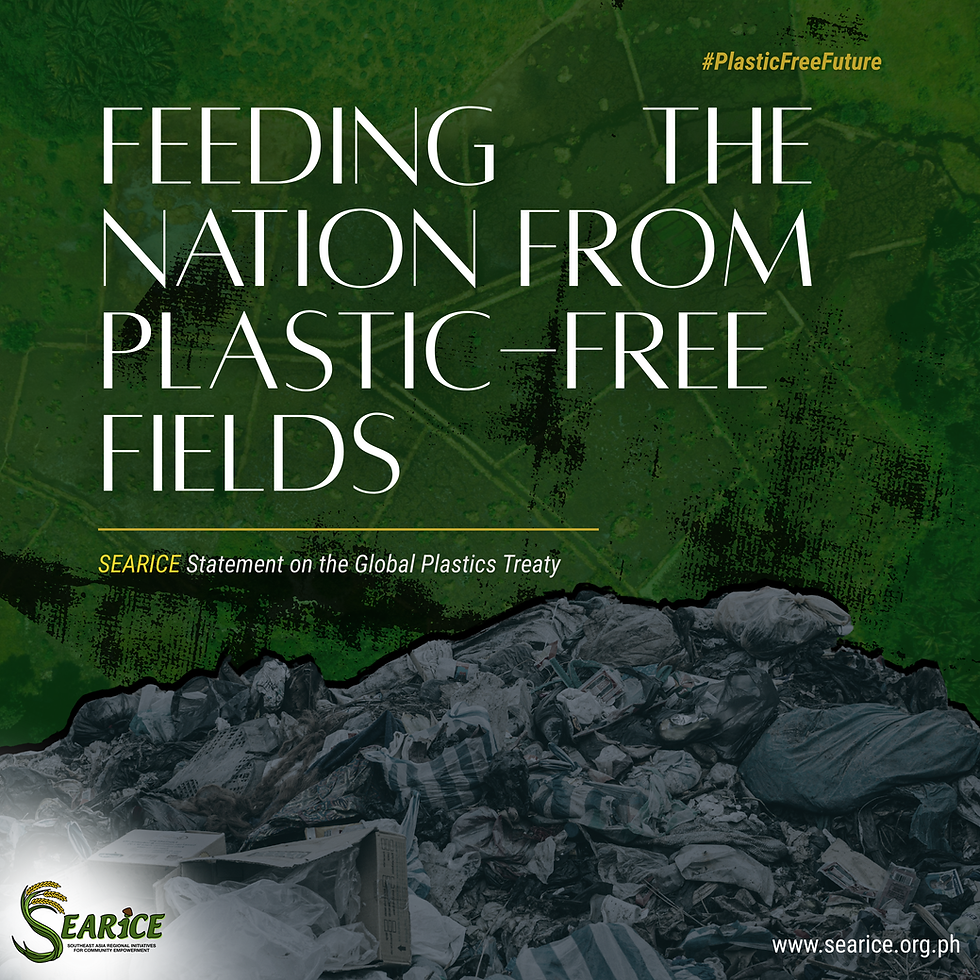SEARICE statement at the 18th meeting of the Convention on Biological Diversity (CBD)Subsidiary Body on Scientific, Technical and Technological Advice (SBSTTA)
- SEARICE Staff
- Jun 28, 2014
- 4 min read
Updated: Sep 19, 2024
SEARICE Position Statement on the Integration of the Conservation and Sustainable Use of Biodiversity into Climate Change Mitigation and Adaptation Activities (Item 9.1)
SEARICE thanks the Secretariat for compiling information found in UNEP/CBD/SBSTTA/18/13. However, decisions IX/16, X/33, and XI/21 relevant to biodiversity and climate change show that climate change is not only relevant to Aichi Targets 10 and 15, but also to Aichi Targets 7, 13 and 14[1]. Consequently, UNEP/CBD/SBSTTA/18/13 needs to be expanded to include other relevant Aichi targets, and not only be limited to assessing REDD+, which comprised the substantial content of UNEP/CBD/SBSTTA/18/13.
It must be stressed that decisions IX/16, X/33, and XI/21, have requested Parties, other Governments and relevant organizations, inter alia,
(a) To identify regions, ecosystems and components of biodiversity that are vulnerable to climate change; and assess the threats and impacts of climate change;
(b) x x x
(c) To take appropriate actions to address and reduce the impacts of climate change, and climate change mitigation and adaptation activities, on biodiversity and biodiversity-based livelihoods, including implementation of ecosystem-based approaches to climate change mitigation and adaptation;
(d) To monitor the impacts of climate change on biodiversity and biodiversity-based livelihoods; x x x
There is an urgent need to identify agricultural biodiversity as one of the components of biodiversity inasmuch as the agricultural sector has been identified to be one of the most vulnerable to the impacts of climate change. The Declaration of the
[1] Target 7. By 2020 areas under agriculture, aquaculture and forestry are managed sustainably, ensuring conservation of biodiversity.
Target 13. By 2020, the genetic diversity of cultivated plants and farmed and domesticated animals and of wild relatives, including other socio-economically as well as culturally valuable species, is maintained, and strategies have been developed and implemented for minimizing genetic erosion and safeguarding their genetic diversity.
Target 14. By 2020, ecosystems that provide essential services, including services related to water, and contribute to health, livelihoods and well-being, are restored and safeguarded, taking into account the needs of women, indigenous and local communities, and the poor and vulnerable.
The World Summit on Food in November 2009 stated: “Climate change poses additional severe risks to food security and the agriculture sector.
There is also a need to monitor the impacts of climate change on biodiversity and biodiversity-based livelihoods, particularly, smallholder farmers or small farming families. The Declaration of the World Food Summit on Food in November 2009 also declared that, “[I]ts expected impact is particularly fraught with danger for smallholder farmers in developing countries, notably the Least Developed Countries (LDCs), and for already vulnerable populations.”
Further, there is a need to introduce the language and concept of loss and damage to the CBD programs of work as part of the overall strategy to mainstream climate change into biodiversity plans. We note that, at the 19th COP of the UNFCCC, Parties to that Convention decided to establish the Warsaw International Mechanism for Loss and Damage, acknowledging that loss and damage associated with the adverse effects of climate change includes, and in some cases involves more than, that which can be reduced by adaptation.
The United Nations University (UNU) released a study in November 2013, stating that the concept of loss and damage is “not about marginal management and standard adaptation practice.” It stated that both economic and non-economic “loss and damage occur when there are barriers that impede planning and implementation of adaptation, and when physical and social limits to adaptation are reached or exceeded.” They found that “the impact of climate-related stressors was primarily on crop cultivation.”
The IPCC’s 5th assessment report touched upon the physical limits to adaptation in cultivation. It found that Cambodia, Laos, Thailand, Myanmar, and the Philippines are already approaching critical levels of heat stress during susceptible stages of the rice plant. Adaptive capacity of crops is projected to be exceeded in low-latitude areas with temperature increases of more than 3 degree Celsius. The UNU study and others before it illustrate that “people in vulnerable countries already appear to be approaching the biophysical and social boundaries of adaptation, beyond which climate change compromises sustainable development.”
Non-economic losses include severe hunger, through reduced food intake, which can be devastating especially for young children and pregnant women. It can also cover loss of traditional knowledge, relevant to Aichi Targets 18 and 13. Sometimes planting their traditionally grown varieties, and even changing varieties, is not enough to weather climate stressors. In severe cases, farmers lose their identity among farmer pastoralists as they are forced to give up crop cultivation and move to urban centers. The disintegration of these traditional livelihoods will be devastating for biodiversity conservation and sustainable use. A clearer picture of loss and damage gives an opportunity to drive transition and transformation in mitigation and adaptation.
To this end, and in recognition of 2014 as the International Year of Family Farming, as declared by the United Nations General Assembly, the following recommendations are suggested:
1. To assess the threats and impacts, including loss and damage, of climate change on agricultural biodiversity;
2. To take appropriate actions to address and reduce the impacts of climate change, and climate change mitigation and adaptation, including loss and damage, activities, particularly on agricultural biodiversity, including implementation of ecosystem-based approaches to climate change mitigation and adaptation;
3. To monitor the impacts of climate change on small farming families;
4. To work closely with the Executive Committee of the Warsaw International Mechanism on Loss and Damage to provide input on biodiversity issues of loss and damage, in particular by addressing loss and damage through enhanced climate risk management; and
5. To invite Parties and other governments to include loss and damage in their reports on mitigation and adaptation activities affecting biodiversity.


